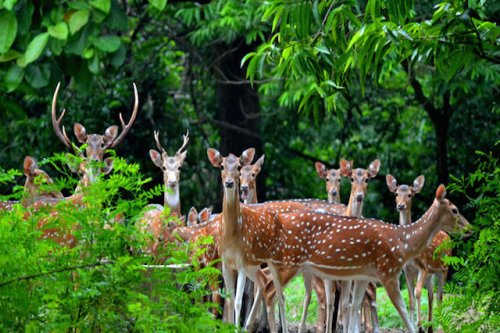When you are based in Kolkata and looking to escape into nature, the region around offers some truly remarkable wildlife sanctuaries. From the mangrove labyrinths of the Sundarbans to the green hills of North Bengal, these protected areas present rich biodiversity, fascinating species, and memorable wildlife-encounters. In this article we explore ten of the top choices within reachable distance of Kolkata—covering what makes each sanctuary special, how to get there, what you’re likely to see, and visitor-tips that will enhance your experience. 1. Chintamoni Kar Bird Sanctuary (near Kolkata) Located just south of the city proper, this sanctuary is a fine first stop. Overview The Chintamoni Kar Bird Sanctuary (formerly known as Kayaler Bagan) lies in the South 24 Parganas district, about 20 km from Kolkata. Wildlife & features Here you’ll find a lush orchard-forest setup, with fruit trees and a rich variety of birds, butterflies, ferns and orchids. It’s particularly attractive for bird-watchers and those wanting a gentle nature-outing without travelling for hours. Why visit Because of proximity to the city, it offers an easy green retreat. It’s less about big mammals and more about quiet nature, bird-life and orchids. Visitor tip Visit early in the morning for better bird sightings and avoid heavy traffic times. Check the access routes from Kolkata (e.g., via Narendrapur). 2. Bethuadahari Wildlife Sanctuary (Nadia district) Overview Bethuadahari Wildlife Sanctuary is located in the Nadia district of West Bengal, beside National Highway 12 (old NH-34), in the Nakashipara area. It covers about 67 hectares and was founded in 1980. Wildlife & features The fauna includes spotted deer (chital), Bengal fox, jackal, porcupine, common langur, as well as rich bird life (parakeets, cuckoos etc) and reptiles such as pythons and gharials (small crocodile-type). The vegetation is part of the Gangetic alluvial eco-zone. Why visit It’s a compact yet diverse sanctuary that offers an accessible nature experience close to the plains around Kolkata, suitable for a half-day or short getaway. Visitor tip Since the area is comparatively small, consider combining it with a drive through nearby countryside or railway journey from Kolkata, for a fuller experience. 3. Bibhutibhushan Wildlife Sanctuary (North 24 Parganas Overview Previously known as Parmadan Forest, this sanctuary is in North 24 Parganas district, about 100 km from Kolkata (near Bongaon) on the banks of the Ichamati River. Wildlife & features Despite its modest size (≈0.68 km²) it hosts more than 200 deer, various bird species and langurs. It offers an opportunity for nature-walks and is less crowded than some of the larger parks. Why visit Good for a quiet forest-walk, spotting deer and birds, and escaping the bustle of the city; especially useful for a day-trip. Visitor tip Infrastructure may be limited (as per some reviews) so plan accordingly (carry water, pick timings). 4. Haliday Island Wildlife Sanctuary (in the Sundarbans region) Overview Part of the larger Sundarbans Biosphere Reserve, Haliday Island WLS lies along the Matla River in South 24 Parganas. The area spans about 5.95 km². Wildlife & features It is known for mangrove forests, estuarine fauna and sometimes even the presence of Bengal tigers (from nearby Sundarbans core). Additionally, you may glimpse spotted deer, wild boar and birds adapted to the mangrove ecosystem. Why visit This sanctuary provides a distinct ecosystem compared to the inland forests—mangrove, tidal creeks and coastal interface. For a unique nature experience near Kolkata, this is hard to rival. Visitor tip Because access requires boat/launch from jetties like Namkhana, Ramganga or Jharkhali, plan transport in advance. Best time is October to March (avoid high-tide or storm seasons). 5. Sajnekhali Wildlife Sanctuary (Northern Sundarbans) Overview Situated within the Sundarbans delta, Sajnekhali WLS covers an area of ~362 km² and lies in South 24 Parganas. Wildlife & features It is home to mangrove habitats, spotted deer, fishing cats, wild boar, crocodiles, and a wide variety of bird species. Why visit For those prepared for a slightly more remote experience, Sajnekhali offers a deeper immersion in mangrove and delta-wildlife, ideal for birding and nature photography. Visitor tip Plan overnight stay or early morning boat trips for richer wildlife sightings; check tide schedules and local guides. 6. Mahananda Wildlife Sanctuary (Darjeeling foothills Overview Located in the Darjeeling district of West Bengal, in the Himalayan foothills, Mahananda WLS offers a cooler forest environment. Wildlife & features It supports over 300 plant species and hosts mammals such as Himalayan black bear, leopards, mountain goats (serow), porcupines, sambar and barking deer. Why visit A great choice if you are willing to travel further from Kolkata and want a hill forest experience rather than plain or coastal zones. The difference in altitude brings different flora/fauna. Visitor tip Combine with a stay in Darjeeling region; note that distances and travel time will be more significant compared to the Bengal plains. 7. Senchal Wildlife Sanctuary (Darjeeling) Overview Founded in 1915, Senchal WLS is one of India’s older protected forests, located just outside Darjeeling town in West Bengal. Wildlife & features At elevations of ~1500-2600 m, the sanctuary supports species like barking deer, wild pig, Himalayan black bear, jungle cat, flying squirrel, and over 350 species of flowering plants including rhododendrons and orchids. Why visit If you’re seeking cooler temperatures, high-altitude forest ambience, and botanical variety, this sanctuary is a top option. Visitor tip Best visited outside monsoon season; early morning or evening walks will give the best experience of forest atmosphere and wildlife sighting. 8. Buxa Tiger Reserve (Alipurduar region) Overview Situated in the Alipurduar area of northern West Bengal, Buxa Tiger Reserve is among the richer wildlife zones of the region. Wildlife & features Here you may encounter Asiatic elephants, rhinos, rare birds such as white-rumped vulture, slender-billed vulture, chestnut-breasted partridge, rufous-necked hornbill, leopard cats, hispid hares, and hog deer. The biodiversity includes over 450 tree species and 150 kinds of orchids. Why visit For a true “wild forest” experience in Bengal, with large mammals and birds in semi-remote terrain, Buxa is excellent. Visitor tip Since it’s farther from Kolkata and more remote, plan 2-3 days, include safari/forest guide, and ensure accommodation is pre-booked. 9. Raiganj Wildlife Sanctuary (Uttar Dinajpur district) Overview Also known as Kulik Bird Sanctuary, Raiganj WLS is in Uttar Dinajpur district and is famed for its bird populations. Wildlife & features It supports over 160 species of birds and attracts around 90,000 migratory birds annually. The habitat is more avian-focused than large-mammal-rich. Why visit An excellent choice for bird-watchers, photographers and nature-students; especially suited for lighter nature outings rather than heavy jungle safaris. Visitor tip Carry binoculars, consider early-morning visits when bird activity is highest, and combine with nearby cultural visits for a richer trip. 10. Lothian Island Wildlife Sanctuary (Sundarbans delta) Overview Located at the confluence of the Bay of Bengal and the Saptamukhi River, Lothian Island WLS is part of the greater Sundarbans ecosystem in South 24 Parganas. Wildlife & features This island sanctuary is distinguished by estuarine crocodiles, olive-ridley sea turtles, spotted deer, jungle cats, rhesus macaque, and a variety of water-birds and shore-birds. Why visit For a coastal-wildlife experience very different from inland forests. The combination of tidal systems, mangroves, and island forest make it unique near Kolkata. Visitor tip Expect boat travel, check tide times, carry insect repellent and prepare for limited amenities. Best visited October–March for safer conditions. Conclusion Exploring the wildlife sanctuaries around Kolkata allows you to experience a wide spectrum of India’s natural heritage—from mangrove deltas to Himalayan foothills, from bird-havens to deer and rhino habitats. Whether you’re seeking a short day-trip or a multi-day jungle foray, the state of West Bengal offers accessible yet diverse protected areas. Remember to respect wildlife rules, go with certified guides where required, and choose times of day or seasons that enhance the chances of sightings. By planning well, your visit to these sanctuaries can be both enriching and memorable.

